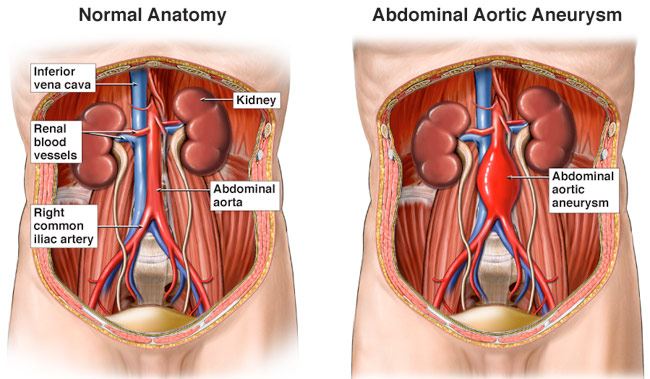Aneurysm
Aneurysms occur when part of an artery wall weakens. This causes an abnormally large bulge. This bulge can burst and cause internal bleeding which can lead to a stroke (if aneurysm is in the brain) or massive internal bleeding (if the aneurysm is in the chest or abdomen). Although an aneurysm can occur in any part of the body, they are most commonly developed in the belly or chest portions of your aorta. The aorta is the major artery that leads from your heart and runs through your chest and abdomen. Aneurysms can develop slowly over many years and become large before causing any symptoms. Often doctors can prevent aneurysms from bursting if they find and treat them early. If so, aneurysms will require constant monitoring with regular check-ups.
Types of Aneurysms
-
Aortic Aneurysm: The most common type of aneurysm. Aortic aneurysms are silent killers with
95 percent of them not showing any symptoms. That is, until a major cardiac
event occurs (aortic dissection, rupture, or death). Aortic aneurysms may be tube-shaped or round. Aortic
aneurysms include:
-
Abdominal Aortic Aneurysm: An abdominal aortic aneurysm develops in the lower part of the aorta.
Because the aorta is the body's main supplier of blood, a ruptured abdominal
aortic aneurysm can cause life-threatening bleeding.

Medical Illustration Copyright © 2019 Nucleus Medical Media, All rights reserved. - Thoracic Aortic Aneurysm: A thoracic aortic aneurysm is an expansion, or ballooning of a section of the aorta within your chest (thorax) that slowly degenerates. The larger the aneurysm, the higher the risk it may rupture, leading to damage of the aortic wall and bleeding that could cause death.
- Dissecting Aneurysm: A dissecting aneurysm can develop anywhere in the aorta but is most common near the heart or in the upper chest. It is caused by a tear in the inner lining of the aorta, resulting in blood flow within the wall of the blood vessel. This tearing can cause bulging of the vessel or obstruction of major branches of the aorta. This condition is always life-threatening.
-
Abdominal Aortic Aneurysm: An abdominal aortic aneurysm develops in the lower part of the aorta.
Because the aorta is the body's main supplier of blood, a ruptured abdominal
aortic aneurysm can cause life-threatening bleeding.
- Brain Aneurysm: This type of aneurysm develops in a blood vessel within the brain. A brain aneurysm can leak or rupture, causing bleeding into the brain (hemorrhagic stroke). A ruptured aneurysm quickly becomes life-threatening and requires prompt medical treatment. Most brain aneurysms, however, don't rupture.
- Popliteal Artery Aneurysm: A peripheral aneurysm develops in the wall of the popliteal artery. This artery supplies blood to the knee joint, thigh and calf. This type of aortic aneurysm can burst, which may cause life-threatening, uncontrolled bleeding.
- Mesenteric Artery Aneurysm: A mesenteric artery aneurysm occurs in either the inferior or superior mesenteric arteries. These arteries carry oxygen-rich blood to the gastrointestinal tract (stomach, intestines, colon and rectum).
- Splenic Artery Aneurysm: A splenic artery aneurysm affects the splenic artery, which supplies blood to the spleen, an organ that helps filter the blood as part of the immune system.
Causes of Aneurysms
Although the exact cause of aneurysms is unknown, certain traits, conditions or habits may raise your risk for the disease. These conditions are known as risk factors and include non-modifiable and modifiable risk factors.
Non-Modifiable Risk Factors: These factors are irreversible and cannot be changed. The more of these risk factors you have, the greater your chance of developing aneurysms.
- Family history/genetics
- Most aneurysms tend to develop after the age of 40.
Modifiable Risk Factors: These factors can be modified, treated or controlled through medications or lifestyle changes.
- High blood pressure
- High cholesterol
- Long history of cigarette smoking and/or drug abuse.
- Obesity or having a body mass index “BMI” of 30 or greater.
Other conditions that contribute to development of aneurysms:
- Trauma from injury
- Atherosclerosis
Symptoms of Aneurysms
Aneurysms can develop slowly over many years and often have no symptoms. However, if an aneurysm expands quickly or ruptures, symptoms may develop suddenly. Some of the symptoms include:
- B.E. F.A.S.T: balance loss, eye blurriness, face drooping, arm weakness, speech difficulty? Time to call 911.
- Sudden numbness or weakness of face, arm, or leg.
- Sudden confusion, trouble speaking or understanding speech.
- Sudden trouble seeing in one or both eyes.
- Sudden trouble walking, dizziness, loss of balance or coordination.
- Sudden severe headache
- Sensitivity to light
- Lightheadedness/fainting
- Wet or sweaty skin
- Low blood pressure
- Nausea and/or vomiting
- Rapid heart rate (tachycardia) of more than 100 beats per minute.
- Heart murmur
Diagnosis of Aneurysms
Sometimes the aneurysm can be felt or even seen on physical examination. More commonly, your doctor may use several tests, depending on the type of aneurysm. Some of the diagnostic tests that may be used include:
Treatment of Aneurysms
Treatment varies from watchful waiting to elective surgery or even emergency surgery. The choice depends on the location, size and condition of the aneurysm and the status of the patient. Treatment options include lifestyle changes, medications and medical and surgical procedures.
Lifestyle Changes
- Avoid smoking.
- Eat a heart-healthy diet.
- Exercise under the directions of your doctor.
- If you're overweight, talk to your doctor about weight loss options.
- Manage stress.
- Make and keep appointments to see your doctor for routine checkups and follow-up tests.
Medications
- Beta blockers will help reduce your blood pressure.
- Statins will help reduce the level of cholesterol in the blood.
